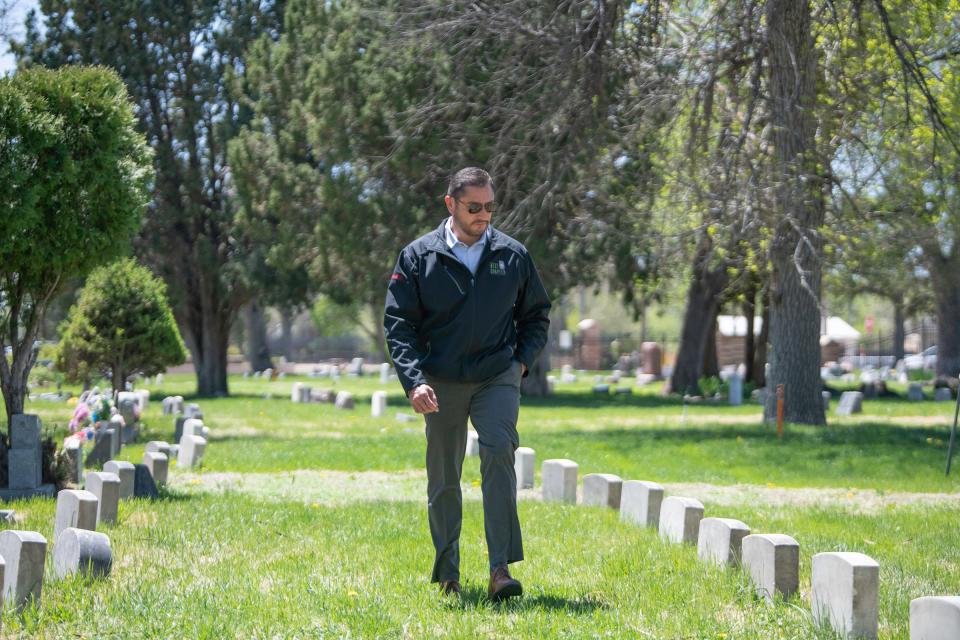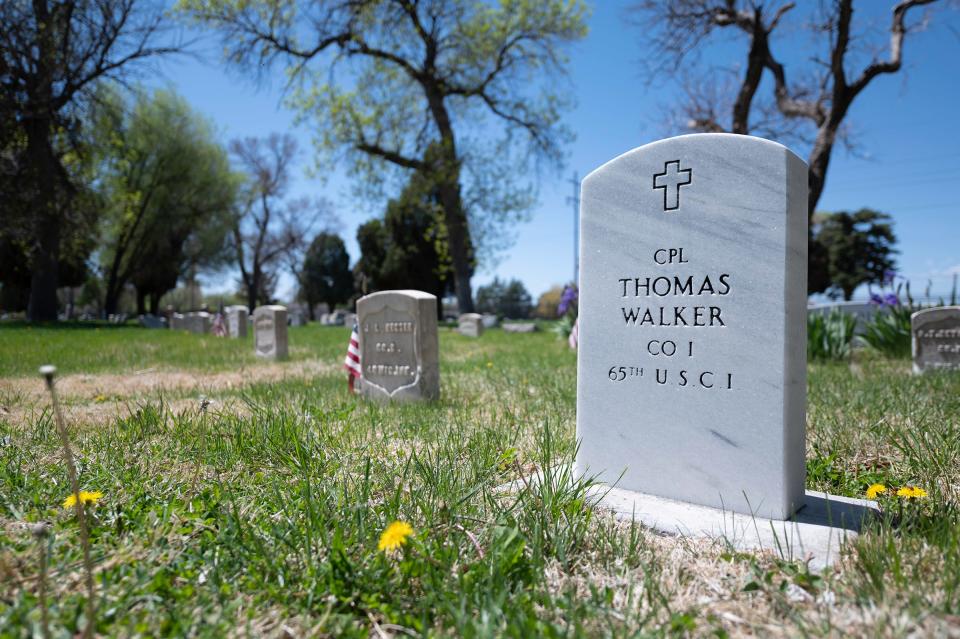'Honor our heroes': Veteran gravesite mapping project taking place at Roselawn Cemetery
A Pueblo veteran wants to honor and recognize the Steel City’s roots as the “Home of Heroes.”
Jose Ramirez, project manager of the veteran program Next Chapter, and a group of volunteers will spend the first two Saturdays of May at Roselawn Cemetery. The goal: map out and identify what Ramirez estimates are more than 3,000 veterans who are laid to rest there.
Ramirez won’t be short on help. Over 100 volunteers have signed up to help him map 125 acres at Roselawn so those veterans can be honored on Memorial Day, Veterans Day and in December for Wreaths Across America.
Roselawn Cemetery’s database has information on where people are buried, but it does not identify if they were veterans, said Ray Brown, facility and grounds director at Roselawn Cemetery and president of the Roselawn Foundation.
The mapping will help Roselawn update its database to identify veterans and give their loved ones an opportunity to honor them not just during those federal holidays, but throughout the year.
“Next Chapter is not just about behavioral health, it's about supporting veterans and their family members in whichever way we can help them do that,” Ramirez said. “For some veterans that come out here and do this, it’s kind of like a healing process or could help them with their grievance or any issues they're going through, helping out other soldiers.
“I mean, when you're in the military, it’s all about looking out for the person to your left or right. This is kind of like the same (act).”

How the mapping will work
Ramirez, a 25-year veteran who served most of his time with the Army, was born in Pueblo and grew up on the East Side. He knew then that Pueblo felt proud of its veterans and came to see it more when people started signing up to help him.
“Growing up here, this has always been a veteran town,” Ramirez said. “It’s always been very proud of its veterans and the community has always supported them. Having 110 volunteers for this event, that’s just a reflection that that sense of pride still exists.”
In groups, those volunteers will map the cemetery, which Ramirez divided into specific grids. Each volunteer will check gravesites to identify whether they have a specific veteran marker, such as a medallion or placard. They will place a blue flag next to the site if they identify the person buried there as a veteran, so it can be cataloged and plugged into the database.
Ramirez said veterans who participate in the mapping also plan to lay a penny at the sites to signify they came to visit. Others may leave dimes, nickels, or quarters to indicate they trained or served with the veteran.
As part of the cataloging, Ramirez and others will take pictures of the sites and input other information to make them easier to find and access.
“We want to transfer all that information onto (Roselawn’s) database to streamline the process for people finding their loved ones,” Ramirez said. “On top of that, it’s going to give us accurate accountability of all the veterans that are here.”
More: Are camping bans constitutional? How a Supreme Court case could impact Pueblo law
Next Chapter seeks accurate count of veterans at Roselawn
Next Chapter laid out 2,070 wreaths in December as part of Wreaths Across America. They ran out of wreaths, though, and started using blue flags before running out of those, too.
There remained dozens more headstones of veterans, however, that Ramirez and others could not uncover because they were covered in snow. That left Ramirez believing there could be well over 3,000 veterans laid to rest at Roselawn, many of whom aren’t honored during the annual ceremony because of an inaccurate count and lack of information in the database.
When Roselawn officials created the database in the late 1800s and early 1900s, they didn’t include veteran status on their reports, Brown said. When Roselawn went to update its database, that information wasn’t available and Brown, on his own, could not map out dozens of acres.

“I think it’s important that if you’re going to be part of Wreaths Across America, that we have an accurate count so we know how many wreaths we need,” Ramirez said.
Some Roselawn staff members plan to pitch in and help during the mapping, Brown said. They also intend to update the database continuously and add veterans to it when they are laid to rest there.
“That is something that we’re going to continue to work on,” Brown said. “(This is) not just a two-day event, this will be ongoing. So not only are we looking forward to completing this project at Roselawn, but we’re excited that the other cemeteries in Pueblo will be moving forward to identify all the veterans in their cemeteries as well.”
Plans in the works to identify more Pueblo veterans and their stories
Though this is the first mapping effort by Ramirez and Next Chapter in Pueblo, it won’t be the last one this year. In August, he plans to map out Imperial Memorial Gardens Cemetery, which also doesn’t have an exact count of veterans who have sites there, he said.
Both events are expected to help streamline how veterans are honored and make it easier for their families to do so, but Ramirez hopes they can also help uncover the history and stories of service members and those who helped them.
That includes the little-known story about Mary Babnik Brown, a Pueblo woman who donated her well-kept, long hair to the U.S. military during World War II. Her hair had been used to create a reticle during the Norden bombsight, a key part of the Air Force’s bombing campaign during the war.
Ramirez and Brown are also encouraging family members to come forward if they have a relative who served but doesn’t have a marker at Roselawn identifying their service. Ramirez provided an email — jose.ramirez@uchealth.org — that people can reach out to if they are interested in volunteering.
Other community organizations, such as UCHealth Parkview, Veterans Upward Bound, American Legion Post 2 and the Roselawn Foundation, among others, are lending support to the effort.
“There’s a lot of history here,” Ramirez said. “I mean, this is the hometown of heroes for a reason. We need to continue to honor our heroes.”
Chieftain reporter Josué Perez can be reached at JHPerez@gannett.com. Follow him on X, formerly Twitter, at @josuepwrites. Support local news, subscribe to The Pueblo Chieftain at subscribe.chieftain.com.
This article originally appeared on The Pueblo Chieftain: Pueblo vet leads effort to map veteran gravesites at Roselawn Cemetery

